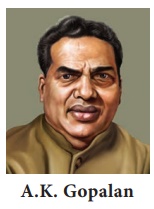Indian Judiciary | Political Science - Judicial Review, Public Interest Litigation And Judicial Activism | 12th Political Science : Chapter 4 : Indian Judiciary
Chapter: 12th Political Science : Chapter 4 : Indian Judiciary
Judicial Review, Public Interest Litigation And Judicial Activism
Judicial Review, Public Interest Litigation And
Judicial Activism
Judicial Review
The Supreme Court and the High Courts in India are
entrusted with the power of judicial review, which extends to adjudicating upon
the Constitutionality of legislations as well as the legality of executive
action.
Parliamentary and State legislations which
contravened Constitutional requirements have been struck down by Judiciary.
Judicial review has been extended
to review ability of Constitutional amendments by evolving the doctrine of the
basic structure of the Constitution according to which a Constitutional
amendment which destroys or damages an essential feature of the Constitution,
for example secularism, democracy and federalism, would be unconstitutional.
Public Interest Litigation
Any citizen of India can approach the courts for
public case (upon the interest of the public) by filing a petition under the
Supreme Court by article 32, (b) in the High Court under article 226 and (c) in
the magistrate court under section 133 of the CRPC. The guidelines provide that
Public interest Litigations can be filed under the following categories: 1. Bonded
labour matters, 2. Neglected children, 3. Non- payment of minimum wages, 4.
Petitions from jails complaining of harassment, death in jail, speedy trial as
a fundamental right etc. 5. Petitions against police for refusing to register a
case, harassment of bride, bride burning, rape, murder, kidnapping etc. 6.
Petitions complaining harassment or torture of persons belonging to scheduled
caste and scheduled tribes. 7. Petitions pertaining to environmental pollution.
The
Public interest Litigation jurisdiction forged by the Supreme Court is an
extension of its jurisdiction under article 32 of the Constitution. Public
interest Litigation is not in the nature of adversary litigation, but it is a
challenge and an opportunity to the government and its officers to make such
issues as human rights meaningful to the deprived and vulnerable sections of
the society and to assure them socio-economic justice which is the signature
tune of the Constitution. A Public interest Litigation may be filed against
state and central government, municipal authority, but not against any private
party.
Recently in India, many cases from the area of
Public interest Litigation has come into picture which has been filed in the
court of law. As in 2005 a case was decided by the Supreme Court named Common
cause society Vs. Union of India. In this Public interest Litigation, the
petitioner filed a Public interest Litigation praying to the court to enact a
road safety act in view of the numerous road accidents. Secondly, in the
Sangammal Pandey Vs. State of UP case the Lucknow bench of the High Court
stayed construction activities near Kanshiram memorial up to a specific date.
In the
Peoples union for democratic rights Vs. Union of India case, the Supreme Court
permitted Public interest Litigations at the instance of ‘public spirited
citizens’ for the enforcement of Constitutional and legal rights of any person
or group of persons who because of their socially or economically disadvantaged
position are unable to approach the courts for relief. Public interest
Litigation is a part of the process of ‘participate justice’ and standing in
civil litigation, of that pattern which has liberal reception at the judicial
doorsteps.

In the
Parmanand Katara vs. Union of India case the Supreme Court held in the Public
interest Litigation filed by a human rights activist fighting for general
public interest, that it is a paramount obligation of every member of the
medical profession to give medical aid to every injured citizen as soon as
possible without waiting for any procedural formalities.
The law
making has assumed new dimensions through judicial activism of the courts. The
judiciary has adopted a healthy trend of interpreting law in social context.
Judicial activism describes judicial rulings suspected of being based on
personal or political considerations rather than on existing law. The question
of judicial activism is closely related to Constitutional interpretation,
statutory constructions and separation of powers.
The Indian judiciary, being a wing of the State has
thus played a more activist role than its US counterpart in seeking to transform
Indian society into a modern one, by enforcing the modern principles and ideas
in the Constitution through court verdicts. Article 21 of the Constitution has
been called up frequently in the Supreme Court. Judgments upon thia article
suggest the trends of judicial activism.
Judicial Activism
Judicial activism as a dynamic
process of judicial outlook in a changing society. Arthur Schlesinger Jr.
introduced the term judicial activism in 1947, in America in an article titled
‘The Supreme Court; 1947’. According to Black’s law dictionary judicial
activism is a judicial philosophy which motivates judges to depart from the
traditional precedents in favour of new progressive social policies.

In the A.K. Gopalan vs. State of Madras case, the
Supreme Court rejected the argument that to deprive a person of his life or
liberty, not only the procedure prescribed by law for doing so must be fair,
but reasonable and just.However, subsequently in Menaka Gandhi vs. Union of
India case this requirement of substantive due process was introduced into article
21 by judicial interpretation. Thus the due process clause, which was avoided
by the Constitution makers, was introduced by judicial activism of the Supreme
Court.
In subsequent decisions, the Supreme Court has
upheld death sentences in cases such as Bagwan Dass vs. State of Delhi case,
which involved honour killing of a man and woman for marrying outside their
caste.

Australian Courts
In Australia, the highest court is
known as the High Court of Australia while the State Courts are known as the
Supreme Court.
Activity
Do you as an Indian
citizen have the right to disagree with judicial opinion? How will you express
your opinion?
In group of three,
discuss and make comments for class discussion on:
a. Criticizing the Judgment of the court
b. Consequences of the criticism
Related Topics